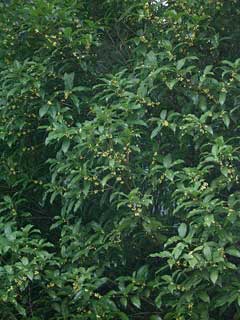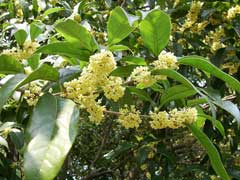 |
|
http://commons.wikimedia.org/wiki/User:Shizhao |
 |
| http://commons.wikimedia.org/wiki/User:Shizhao |
Translate this page:
Summary
Physical Characteristics

 Osmanthus fragrans is an evergreen Shrub growing to 6 m (19ft) by 6 m (19ft).
Osmanthus fragrans is an evergreen Shrub growing to 6 m (19ft) by 6 m (19ft).
See above for USDA hardiness. It is hardy to UK zone 9. It is in leaf all year, in flower from June to August. The species is hermaphrodite (has both male and female organs).
Suitable for: light (sandy), medium (loamy) and heavy (clay) soils. Suitable pH: mildly acid, neutral and basic (mildly alkaline) soils and can grow in very alkaline soils.
It can grow in semi-shade (light woodland) or no shade. It prefers moist soil.
UK Hardiness Map
US Hardiness Map
Synonyms
Olea fragrans.
Plant Habitats
Woodland Garden Sunny Edge; Dappled Shade;
Edible Uses
Edible Parts: Fruit
Edible Uses: Condiment
The unripe fruits are preserved in brine like olives[183]. The very fragrant flowers are used by the Chinese to impart a pleasant aroma to tea, wine and sweet dishes such as lotus seed soup, pastries and steamed pears[2, 46, 61, 183]. They are also added to herbal medicines in order to disguise obnoxious flavours[178]. The flowers have a scent of apricots[146].
References More on Edible Uses
Medicinal Uses
Plants For A Future can not take any responsibility for any adverse effects from the use of plants. Always seek advice from a professional before using a plant medicinally.
Antitussive
The flowers are antitussive[218]. They are used in cosmetics for the hair and skin, but are mostly used to flavour other medicines[218]. A decoction of the stem bark is used in the treatment of boils, carbuncles etc[218]. A past made from the stem or bark is used in the treatment of boils, carbuncles, whoping cough and retinitis[272]. A decoction of the lateral roots is used in the treatment of dysmenorrhoea, rheumatism, bruises etc[218].
References More on Medicinal Uses
The Bookshop: Edible Plant Books
Our Latest books on Perennial Plants For Food Forests and Permaculture Gardens in paperback or digital formats.

Edible Tropical Plants
Food Forest Plants for Hotter Conditions: 250+ Plants For Tropical Food Forests & Permaculture Gardens.
More

Edible Temperate Plants
Plants for Your Food Forest: 500 Plants for Temperate Food Forests & Permaculture Gardens.
More

More Books
PFAF have eight books available in paperback and digital formats. Browse the shop for more information.
Shop Now
Other Uses
Essential Repellent
An essential oil is obtained from the flowers[178]. Used as a flavouring. The flowers are used as an insect repellent for clothes[146].
Special Uses
Scented Plants
References More on Other Uses
Cultivation details
Easily grown in any well-drained soil in sun or part shade[11, 200], but flowering more freely in a sunny position[11]. Thrives in chalky conditions[11]. Dislikes unduly exposed positions[11], and requires shelter from freezing winds[200]. Not very hardy outdoors in Britain[11], it succeeds on a wall in Cornwall[1] or in a woodland garden in the milder areas of the country[166]. The flowers are very fragrant[219]. They are sometimes available in oriental stores, preserved in sweetened brine or as a sugary paste called 'cassia blossom jam'[183].
References Carbon Farming Information and Carbon Sequestration Information
Temperature Converter
Type a value in the Celsius field to convert the value to Fahrenheit:
Fahrenheit:
The PFAF Bookshop
Plants For A Future have a number of books available in paperback and digital form. Book titles include Edible Plants, Edible Perennials, Edible Trees,Edible Shrubs, Woodland Gardening, and Temperate Food Forest Plants. Our new book is Food Forest Plants For Hotter Conditions (Tropical and Sub-Tropical).
Shop Now
Plant Propagation
Seed - best sown as soon as it is ripe in a coldframe[200]. Stored seed probably germinates best if it is given 3 months warm then 3 months cold stratification before sowing[113]. The seed usually takes 6 - 18 months to germinate, it should be pricked out into individual pots when it is large enough to handle. Grow the plants on for their first winter in the greenhouse and plant them out in early summer. Cuttings of half-ripe wood taken at the end of July, in a frame with bottom heat[11]. Cuttings of almost ripe wood, 7 - 12cm with a heel, September/October in a cold frame. A good percentage. Plant out in the spring 18 months later[78]. Layering in spring[200] or autumn[78]. Partially sever the layer leads in the following late summer and plant out in the autumn. High percentage[78].
Other Names
If available other names are mentioned here
Native Range
TEMPERATE ASIA: China (Guizhou Sheng, Sichuan Sheng, Yunnan Sheng), Japan (Kyushu (south)) TROPICAL ASIA: Bhutan, India (Assam, Nagaland, Sikkim), Nepal, Myanmar (north), Thailand (north)
Weed Potential
Right plant wrong place. We are currently updating this section.
Please note that a plant may be invasive in one area but may not in your area so it's worth checking.
Conservation Status
IUCN Red List of Threatened Plants Status :

Growth: S = slow M = medium F = fast. Soil: L = light (sandy) M = medium H = heavy (clay). pH: A = acid N = neutral B = basic (alkaline). Shade: F = full shade S = semi-shade N = no shade. Moisture: D = dry M = Moist We = wet Wa = water.
Now available:
Food Forest Plants for Mediterranean Conditions
350+ Perennial Plants For Mediterranean and Drier Food Forests and Permaculture Gardens.
[Paperback and eBook]
This is the third in Plants For A Future's series of plant guides for food forests tailored to
specific climate zones. Following volumes on temperate and tropical ecosystems, this book focuses
on species suited to Mediterranean conditions—regions with hot, dry summers and cool, wet winters,
often facing the added challenge of climate change.
Read More
Expert comment
Author
Lour.
Botanical References
1158200
Links / References
For a list of references used on this page please go here
Readers comment
| Add a comment |
|
If you have important information about this plant that may help other users please add a comment or link below. Only comments or links that are felt to be directly relevant to a plant will be included. If you think a comment/link or information contained on this page is inaccurate or misleading we would welcome your feedback at [email protected]. If you have questions about a plant please use the Forum on this website as we do not have the resources to answer questions ourselves.
* Please note: the comments by website users are not necessarily those held by PFAF and may give misleading or inaccurate information.
To leave a comment please Register or login here All comments need to be approved so will not appear immediately.
|
Subject : Osmanthus fragrans
|
|
|
|